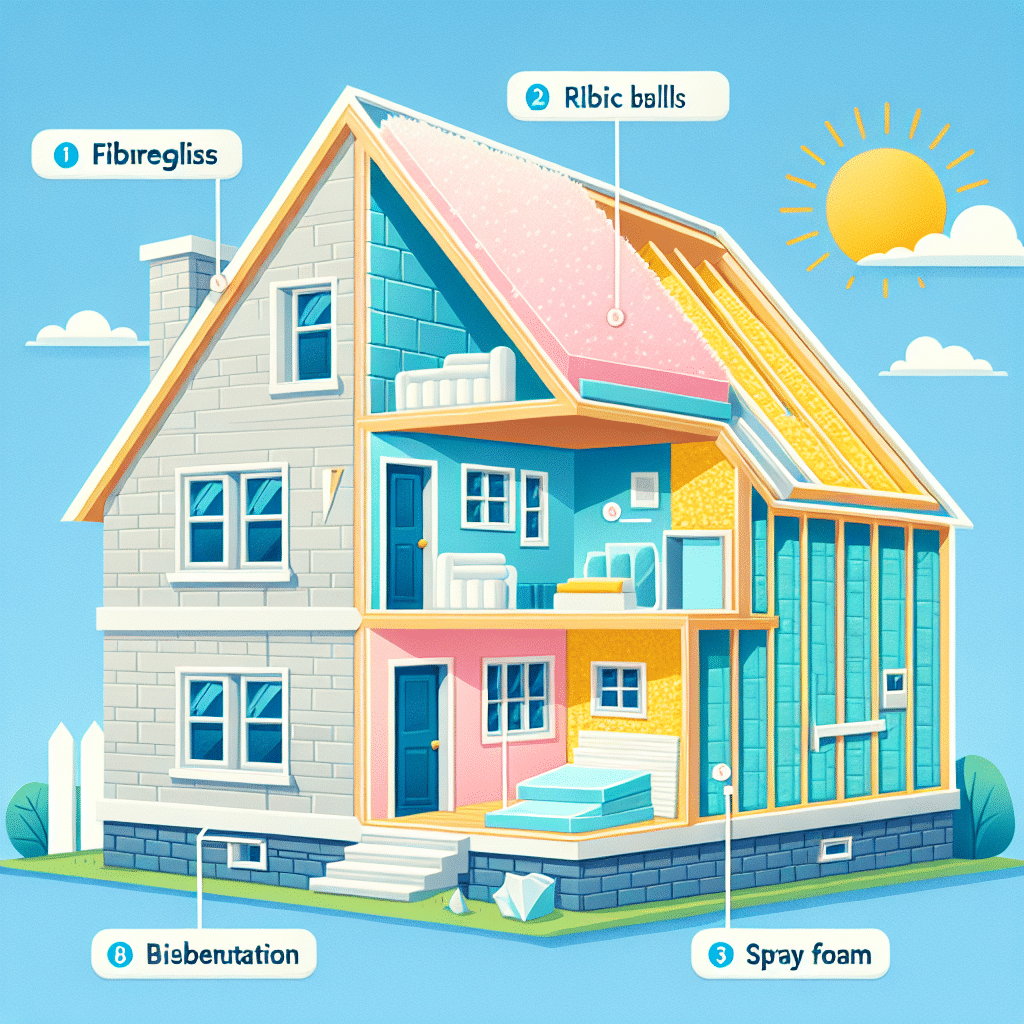Insulation for Different Areas of Your Home
-
Table of Contents
Insulation is a critical component in maintaining energy efficiency, comfort, and cost-effectiveness in your home. Different areas of a house, such as the attic, walls, floors, and basement, require specific types of insulation to address unique thermal and moisture challenges. Proper insulation helps to regulate indoor temperatures, reduce energy consumption, and prevent issues like mold and dampness. By understanding the insulation needs of various parts of your home, you can make informed decisions that enhance overall performance and sustainability.
Benefits Of Attic Insulation For Energy Efficiency
Attic insulation plays a pivotal role in enhancing the energy efficiency of your home, offering a multitude of benefits that extend beyond mere temperature regulation. By understanding the advantages of attic insulation, homeowners can make informed decisions that contribute to both environmental sustainability and financial savings.
One of the primary benefits of attic insulation is its ability to maintain a consistent indoor temperature. During the sweltering summer months, a well-insulated attic prevents the sun’s heat from penetrating the living spaces below, thereby reducing the reliance on air conditioning systems. Conversely, in the frigid winter season, insulation acts as a barrier that retains the warmth generated within the home, minimizing the need for excessive heating. This dual functionality ensures that your home remains comfortable year-round, regardless of external weather conditions.
Moreover, the energy efficiency achieved through attic insulation translates directly into cost savings. By reducing the workload on heating and cooling systems, homeowners can expect a significant decrease in their utility bills. This reduction in energy consumption not only alleviates financial strain but also contributes to a lower carbon footprint. In an era where environmental consciousness is paramount, the decision to insulate your attic aligns with broader efforts to combat climate change and promote sustainable living practices.
In addition to temperature regulation and cost savings, attic insulation also enhances the overall structural integrity of your home. Insulation materials, such as fiberglass, cellulose, or spray foam, provide a protective layer that mitigates the risk of moisture infiltration. Moisture can lead to a host of issues, including mold growth, wood rot, and compromised structural stability. By preventing these problems, attic insulation extends the lifespan of your home and preserves its value over time.
Furthermore, the benefits of attic insulation extend to improved indoor air quality. Insulation helps to seal gaps and cracks that could otherwise allow pollutants, allergens, and outdoor contaminants to enter your living spaces. This is particularly beneficial for individuals with respiratory conditions or allergies, as it creates a healthier indoor environment. By investing in attic insulation, homeowners can enjoy cleaner air and a reduced likelihood of health-related issues stemming from poor air quality.
It is also worth noting that attic insulation can contribute to noise reduction within the home. The insulating materials act as a sound barrier, dampening external noises such as traffic, construction, or neighborhood activities. This added layer of soundproofing enhances the tranquility of your living spaces, allowing for a more peaceful and serene environment.
When considering attic insulation, it is essential to choose the appropriate type and thickness of insulation material to achieve optimal results. Consulting with a professional insulation contractor can provide valuable insights and ensure that the installation is performed correctly. Proper installation is crucial to maximizing the benefits of attic insulation and avoiding potential issues such as thermal bridging or inadequate coverage.
In conclusion, the benefits of attic insulation for energy efficiency are manifold, encompassing temperature regulation, cost savings, structural protection, improved air quality, and noise reduction. By investing in attic insulation, homeowners can create a more comfortable, sustainable, and resilient living environment. The decision to insulate your attic is not merely a financial investment but a commitment to enhancing the overall quality of life within your home.
Choosing The Right Wall Insulation For Maximum Comfort

When selecting wall insulation for your home, it is crucial to consider various factors to ensure maximum comfort and energy efficiency. The right insulation can significantly impact your home’s thermal performance, soundproofing, and overall indoor air quality. To begin with, understanding the different types of insulation materials available is essential. Common options include fiberglass, cellulose, foam board, and spray foam, each offering unique benefits and drawbacks.
Fiberglass insulation, one of the most widely used materials, is known for its affordability and ease of installation. It is available in batts or rolls and can be fitted between wall studs. However, fiberglass may not provide the highest R-value, which measures thermal resistance, and it can be less effective in preventing air leaks. On the other hand, cellulose insulation, made from recycled paper products, offers a higher R-value and better air sealing properties. It is typically blown into wall cavities, ensuring a more uniform coverage. Despite its advantages, cellulose can settle over time, potentially reducing its effectiveness.
Foam board insulation, composed of polystyrene, polyisocyanurate, or polyurethane, provides excellent thermal resistance and moisture control. It is often used in exterior walls to create a continuous insulation layer, minimizing thermal bridging. However, foam board can be more expensive and may require professional installation. Spray foam insulation, available in open-cell and closed-cell varieties, offers superior air sealing and high R-values. It expands to fill gaps and cracks, making it ideal for irregularly shaped spaces. Nevertheless, spray foam can be costly and may necessitate specialized equipment and expertise for proper application.
In addition to material selection, the specific area of your home being insulated plays a significant role in determining the best approach. For exterior walls, continuous insulation systems, such as foam board or spray foam, are highly effective in reducing heat transfer and preventing air infiltration. These systems can be combined with traditional batt or blown-in insulation to enhance overall performance. Interior walls, on the other hand, may benefit more from soundproofing properties. In such cases, materials like mineral wool or dense-packed cellulose can help reduce noise transmission between rooms.
Furthermore, the climate in which you live should influence your insulation choices. In colder regions, higher R-values are necessary to maintain warmth and reduce heating costs. Conversely, in warmer climates, insulation should focus on keeping heat out and maintaining a cool indoor environment. Reflective or radiant barrier insulation can be particularly effective in hot areas, as it reflects radiant heat away from the home.
Proper installation is another critical factor in achieving maximum comfort. Even the best insulation materials can underperform if not installed correctly. Ensuring a tight fit, sealing gaps and cracks, and avoiding compression of the insulation are essential steps. Additionally, considering the integration of a vapor barrier can help control moisture levels within the walls, preventing mold growth and structural damage.
In conclusion, choosing the right wall insulation for your home involves a careful evaluation of material properties, specific area requirements, climate considerations, and installation practices. By taking these factors into account, you can enhance your home’s comfort, energy efficiency, and overall indoor environment. Investing in high-quality insulation not only provides immediate benefits but also contributes to long-term savings and sustainability.
Basement Insulation Solutions To Prevent Moisture And Mold
Basement insulation is a critical aspect of home maintenance that often goes overlooked. Proper insulation in this area not only enhances energy efficiency but also plays a pivotal role in preventing moisture and mold, which can lead to significant structural and health issues. Understanding the various insulation solutions available for basements can help homeowners make informed decisions that protect their investment and ensure a healthy living environment.
One of the primary concerns in basement insulation is moisture control. Basements are inherently prone to dampness due to their location below ground level, where they are in constant contact with the surrounding soil. This contact can lead to water seepage, which, if not properly managed, can create an ideal environment for mold growth. Mold not only damages the structural integrity of the home but also poses serious health risks, including respiratory problems and allergic reactions. Therefore, selecting the right insulation material is crucial.
Closed-cell spray foam insulation is one of the most effective solutions for basement insulation. This type of insulation provides a high R-value, which measures thermal resistance, and acts as an excellent barrier against moisture. When applied, closed-cell spray foam expands to fill gaps and cracks, creating an airtight seal that prevents water vapor from penetrating the walls. Additionally, its dense structure makes it resistant to mold growth, offering a dual benefit of thermal efficiency and moisture control.
Another viable option is rigid foam board insulation. These boards are made from materials such as polystyrene or polyurethane and are known for their moisture-resistant properties. Rigid foam boards can be installed directly against the basement walls, providing a continuous layer of insulation that minimizes thermal bridging and reduces the risk of condensation. To enhance their effectiveness, it is advisable to seal the edges and joints with waterproof tape or caulk, ensuring a comprehensive moisture barrier.
Fiberglass insulation, while commonly used in other parts of the home, requires careful consideration when applied in basements. Traditional fiberglass batts can absorb moisture, leading to mold growth and reduced insulation performance. However, encapsulated fiberglass, which is wrapped in a plastic film, offers a more moisture-resistant alternative. This type of insulation can be installed between wall studs, but it is essential to pair it with a vapor barrier to prevent moisture infiltration.
In addition to selecting the appropriate insulation material, proper installation techniques are paramount. Before insulating, it is crucial to address any existing moisture issues. This may involve repairing foundation cracks, installing a sump pump, or improving exterior drainage systems to divert water away from the foundation. Once these issues are resolved, a vapor barrier should be installed on the interior side of the basement walls to further protect against moisture.
Furthermore, it is important to consider the insulation of basement floors. Insulating the floor can prevent cold air from seeping into the living space above and reduce the risk of condensation on the floor surface. Rigid foam board insulation is a popular choice for basement floors due to its durability and moisture resistance. It can be installed beneath a subfloor or directly under a finished flooring material.
In conclusion, basement insulation is a multifaceted process that requires careful selection of materials and meticulous installation to effectively prevent moisture and mold. By opting for solutions such as closed-cell spray foam, rigid foam board, or encapsulated fiberglass, homeowners can create a well-insulated, moisture-resistant basement environment. Addressing moisture issues before insulation and incorporating vapor barriers are essential steps in this process. Ultimately, investing in proper basement insulation not only enhances energy efficiency but also safeguards the home’s structural integrity and the health of its occupants.
Read more about Home Insulation
- Types of Home Insulation
- Benefits of Home Insulation
- Choosing the Right Insulation for Your Home
- Common DIY Home Insulation Mistakes
- Signs of Poor Home Insulation
- Home Insulation ROI (Return on Investment)
- How to Improve Home Insulation without Breaking the Bank
- Upgrading Home Insulation for Extreme Climates
- Maintaining and Updating Home Insulation







